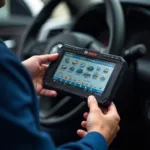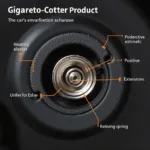A cracked car bumper is an eyesore. It’s also a vulnerability, leaving your car exposed to further damage. Luckily, you don’t always need a professional to fix it. This guide will walk you through how to repair a cracked car bumper yourself, saving you money and getting your car looking its best again.
Assessing the Damage: Can You DIY or See a Pro?
Before you grab your toolbox, you need to determine if your cracked car bumper is a DIY job or requires a professional touch. Here’s a simple breakdown:
DIY Fixes:
- Hairline Cracks: These are superficial and mostly affect the aesthetics of your bumper.
- Small Cracks (Less than 6 inches): These can often be repaired at home with the right materials and a bit of patience.
Professional Help Recommended:
- Large Cracks (Over 6 inches): These often signal structural damage and require specialized tools and expertise for a lasting repair.
- Cracks Near Edges or Corners: These areas are under more stress and DIY fixes might not hold.
- Multiple Cracks or Extensive Damage: This usually calls for professional assessment to determine the best course of action.
DIY Car Bumper Crack Repair: A Step-by-Step Guide
If you’ve determined that your cracked bumper is suitable for a DIY fix, here’s how to tackle the repair:
1. Gather Your Supplies:
- Cleaning Supplies: Soap, water, a clean cloth, and rubbing alcohol.
- Sandpaper: 80-grit, 180-grit, and 400-grit.
- Plastic Bumper Repair Kit: This typically includes a mesh patch, epoxy, hardener, and application tools.
- Masking Tape and Plastic Sheeting: To protect surrounding areas.
- Gloves and Safety Glasses: Protect yourself during the repair process.
2. Prep the Damaged Area:
- Thoroughly clean the cracked area with soap and water, removing dirt, grime, and loose paint.
- Allow the area to dry completely.
- Use masking tape and plastic sheeting to protect the surrounding areas of your car from sanding dust and overspray.
3. Sand and Smooth:
- Using 80-grit sandpaper, roughen the surface of the crack and the area around it. This creates better adhesion for the repair materials.
- Gradually work your way to finer grit sandpaper (180-grit then 400-grit) to smooth out the sanded area.
4. Apply the Repair Material:
- Follow the instructions provided in your chosen plastic bumper repair kit.
- Most kits involve mixing an epoxy resin with a hardener.
- Apply the mixture to the crack, ensuring it fills the entire crevice and slightly overlaps the surrounding area.
- If your kit includes a mesh patch, embed it into the epoxy while it’s still wet. This adds strength and stability to the repair.
5. Shape, Sand, and Smooth (Again!):
- Once the epoxy has cured (refer to the kit’s instructions for drying times), use 180-grit sandpaper to shape the repaired area and blend it with the surrounding bumper surface.
- Again, gradually progress to finer grit sandpaper for a smooth and even finish.
6. Optional: Prime and Paint for a Seamless Finish:
- For a professional look, you can prime and paint the repaired area.
- Choose a primer and paint specifically designed for plastic bumpers.
- Apply thin, even coats, allowing each layer to dry thoroughly before applying the next.
Can a Car Bumper Be Repaired Without Replacing?
Yes, in many cases, a car bumper can be repaired without replacing the entire unit. This is especially true for minor cracks, scratches, and dents. Repairing the bumper is often more cost-effective and can be done at home with the right approach. However, for extensive damage or cracks in critical areas, replacement might be necessary to ensure the structural integrity and safety of your vehicle.
Expert Insights:
“A common mistake people make when repairing car bumper cracks is not prepping the surface properly. Thorough cleaning and sanding are crucial for good adhesion of the repair materials,” says John Smith, an experienced auto body technician.
Conclusion
Repairing a cracked car bumper can seem daunting, but with the right guidance and a little effort, you can restore your car’s appearance and protect it from further damage. Remember to assess the damage carefully before starting, and don’t hesitate to consult a professional if you’re unsure about any part of the process. A little DIY can go a long way in keeping your car looking its best.
FAQs
1. What kind of epoxy is best for car bumper repair?
Look for a two-part epoxy specifically designed for plastic bumper repair. These formulations provide strong adhesion and flexibility.
2. Can I just use superglue to fix a cracked bumper?
While tempting, superglue isn’t ideal for car bumpers. It’s not flexible enough to withstand vibrations and impacts, leading to a weak and short-lived repair.
3. How long does it take for bumper repair epoxy to cure?
Curing times vary depending on the specific product, but most epoxies require at least 24 hours to fully harden.
4. Do I need to prime and paint after repairing the crack?
Priming and painting aren’t always necessary, especially if the repair is in a less visible area. However, for a seamless finish and added protection, it’s recommended.
5. How can I prevent my car bumper from cracking again?
Be mindful of parking curbs, avoid bumping into objects, and address minor scratches and dents promptly to prevent them from worsening into cracks.
You might also be interested in:
Need further assistance with your car repair?
Contact our team of experts 24/7 via WhatsApp: +1(641)206-8880 or Email: [email protected]. We’re always here to help you get back on the road.



